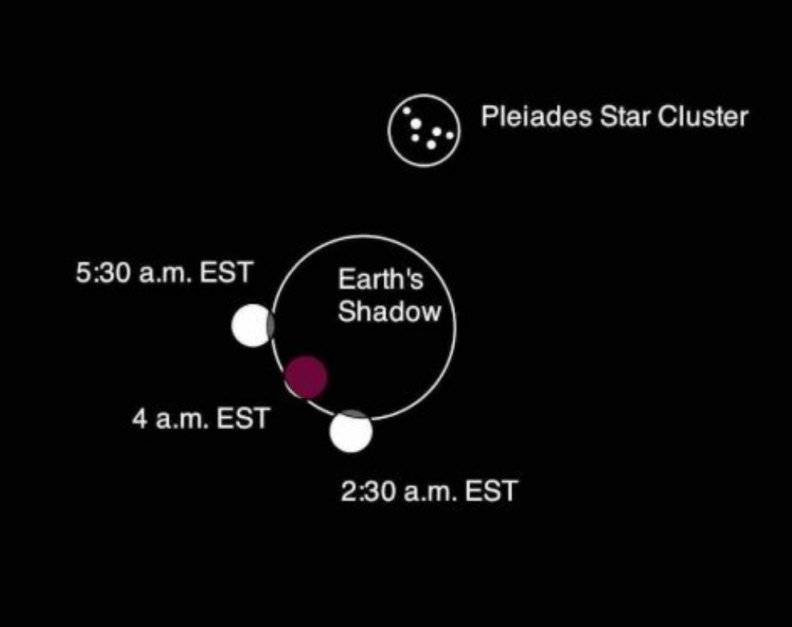Deep partial lunar eclipse November 18-19: Great for North America
 For us in North America, the partial lunar eclipse will take place overnight on November 18, and in the early morning on November 19, 2021. The moon will be high in North American skies, shifting toward the west. In this illustration, the times are in EST. Mid-eclipse will be at about 4 a.m. EST, 3 a.m. CST, 1 a.m. PST, etc. Precise time of mid-eclipse is 9:03 UTC. But watch the creeping shadow on the moon’s disk for an hour or so before that time, too! In this illustration, the white disks represent partially eclipsed moons. The maroon disk represents the moon at greatest eclipse, 97% covered by the Earth’s dark umbral shadow. Watch for the dipper-shaped Pleiades star cluster near the eclipsed moon. Chart by John Jardine Goss
For us in North America, the partial lunar eclipse will take place overnight on November 18, and in the early morning on November 19, 2021. The moon will be high in North American skies, shifting toward the west. In this illustration, the times are in EST. Mid-eclipse will be at about 4 a.m. EST, 3 a.m. CST, 1 a.m. PST, etc. Precise time of mid-eclipse is 9:03 UTC. But watch the creeping shadow on the moon’s disk for an hour or so before that time, too! In this illustration, the white disks represent partially eclipsed moons. The maroon disk represents the moon at greatest eclipse, 97% covered by the Earth’s dark umbral shadow. Watch for the dipper-shaped Pleiades star cluster near the eclipsed moon. Chart by John Jardine Goss
Partial lunar eclipse
A deep partial lunar eclipse will darken the moon for much of the globe on November 19, 2021 (overnight on November 18 for North America). Most locations will see up to 97% of the moon slip into Earth’s shadow. North America has the best location to see the entirety of the eclipse. Find maps and timing for the eclipse below. In some cases, the times are in UTC and you must convert.
Try Adsterra Earnings, it’s 100% Authentic to make money more and more.

This is an exceptionally deep partial eclipse with an umbral eclipse magnitude of 0.9742. In other words, 97% of the moon will be covered by Earth’s dark umbral shadow. With a just thin sliver of the moon exposed to direct sun at maximum eclipse, the rest of the moon should take on the characteristically ruddy colors of a total lunar eclipse.
This is the second lunar eclipse of 2021. See photos of the May 2021 lunar eclipse.
This eclipse occurs at the moon’s ascending node in Taurus. The moon will be placed near the famous Pleiades – aka the Seven Sisters – during the eclipse. Great photo opportunity!
The eclipse takes place 1.7 days before the moon reaches apogee (November 21 at 02:14 UTC), its farthest point from Earth for this month. For that reason, this is also the longest lunar eclipse in a span of some 1,000 years. Read more about the length of this lunar eclipse.
 View larger. | Eclipse timings via Skyandtelescope.com. You can also visit timeanddate.com to get an exact timing of the eclipse from your location.
View larger. | Eclipse timings via Skyandtelescope.com. You can also visit timeanddate.com to get an exact timing of the eclipse from your location.  During a lunar eclipse, 2 shadows are cast. The dark inner part of Earth’s shadow is called the umbra. The 2nd shadow is called the penumbra. During the November 18-19, 2021, partial lunar eclipse, the moon will be 97% covered by Earth’s dark umbral shadow. Illustration via NASA.
During a lunar eclipse, 2 shadows are cast. The dark inner part of Earth’s shadow is called the umbra. The 2nd shadow is called the penumbra. During the November 18-19, 2021, partial lunar eclipse, the moon will be 97% covered by Earth’s dark umbral shadow. Illustration via NASA. Who will see the partial lunar eclipse
Viewers in North America and the Pacific Ocean, Alaska, eastern Australia, New Zealand and Japan will be able to see the entire partial lunar eclipse. Observers in western Asia, Australia, and New Zealand miss the early stages of the eclipse because they occur before moonrise. Similarly, South America and Western Europe experience moonset before the eclipse ends. None of the eclipse is visible from Africa, the Middle East, or western Asia.
At the instant of greatest eclipse (09:02:56 UTC) the moon lies at the zenith for a point in the Pacific Ocean east of the Hawaiian Islands. The moon’s southern limb lies 0.8 arc-minutes outside the edge of the umbral shadow.
Comment from Fred Espenak: This is an extraordinary test case for a marginally partial eclipse.
 View larger. | A map of visibility for the November 18-19, 2021, partial lunar eclipse. The Americas are favored, but observers in northern Europe, eastern Asia, Australia and the Pacific will see it, too. The star marks the point where the maximally eclipsed moon will appear directly overhead. Image via Fred Espenak. Find timing for your location at timeanddate.com.
View larger. | A map of visibility for the November 18-19, 2021, partial lunar eclipse. The Americas are favored, but observers in northern Europe, eastern Asia, Australia and the Pacific will see it, too. The star marks the point where the maximally eclipsed moon will appear directly overhead. Image via Fred Espenak. Find timing for your location at timeanddate.com.  View larger. | This image depicts the moon’s path with respect to Earth’s umbral shadow (in red) and penumbral shadow (in gray). The labels P4, U4, Greatest, P1 and U1 relate to eclipse timings and are explained at EclipseWise.com. The eclipse is almost total, but a tiny portion of the moon’s face will remain outside the dark umbral shadow at mid-eclipse. Image via Fred Espenak. Find eclipse timings for your location at timeanddate.com.
View larger. | This image depicts the moon’s path with respect to Earth’s umbral shadow (in red) and penumbral shadow (in gray). The labels P4, U4, Greatest, P1 and U1 relate to eclipse timings and are explained at EclipseWise.com. The eclipse is almost total, but a tiny portion of the moon’s face will remain outside the dark umbral shadow at mid-eclipse. Image via Fred Espenak. Find eclipse timings for your location at timeanddate.com. Eclipse times
The times of the major eclipse phases are listed as follows. These times are in Universal Time (UTC); translate UTC to your time.
Penumbral Eclipse Begins: 06:02:09 UTC on November 19
Partial Eclipse Begins: 07:18:43 UTC (2:19 a.m. EST in North America)
Greatest Eclipse: 09:02:56 UTC (4:03 a.m. EST)
Partial Eclipse Ends: 10:47:07 UTC (5:47 a.m. EST)
Penumbral Eclipse Ends: 12:03:44 UTC (7:04 a.m. EST)
Find eclipse timings for your location at timeanddate.com.
Also see this Key to Lunar Eclipse Figures.
 The November 18-19, 2021, eclipse is an exceptionally deep partial lunar eclipse. With a just thin sliver of the moon exposed to direct sun at maximum eclipse, the rest of the moon should take on the characteristically ruddy colors of a total lunar eclipse. Image via Joe.
The November 18-19, 2021, eclipse is an exceptionally deep partial lunar eclipse. With a just thin sliver of the moon exposed to direct sun at maximum eclipse, the rest of the moon should take on the characteristically ruddy colors of a total lunar eclipse. Image via Joe. Saros and eclipse season
The eclipse belongs to Saros 126 and is number 45 of 70 eclipses in the series.
All eclipses in this series occur at the moon’s ascending node. The moon moves southward with respect to the node with each succeeding eclipse in the series, and gamma decreases.
The partial lunar eclipse of November 19, 2021, is followed two weeks later by a total solar eclipse on December 4, 2021.
These eclipses all take place during a single eclipse season.
 Thank you, Fred Espenak, for granting permission to reprint this article. For the best in eclipse info – from a world expert – visit Fred Espenak’s publications page.
Thank you, Fred Espenak, for granting permission to reprint this article. For the best in eclipse info – from a world expert – visit Fred Espenak’s publications page. Bottom line: A partial lunar eclipse will occur on Friday, November 19, 2021 (overnight November 18 for North America). It will be visible from the Americas, North Europe, eastern Asia, Australia, and the Pacific. Find eclipse timings for your location at timeanddate.com.
Read more: November 2021 partial lunar eclipse longest for 1,000 years
Fred Espenak
View ArticlesAbout the Author:
Fred Espenak is a scientist emeritus at Goddard Space Flight Center. For decades, he has been NASA’s expert on eclipses, and some of you may know him as Mr. Eclipse. Fred maintains NASA’s official eclipse web site (eclipse.gsfc.nasa.gov) as well as his personal web site on eclipse photography (mreclipse.com). Now retired and living in rural Arizona, Fred spends most clear nights losing sleep and photographing the stars (astropixels.com). His latest website is devoted to helping you enjoy eclipses (www.eclipsewise.com). He is an EarthSky content partner.
Editors of EarthSky
View ArticlesAbout the Author:
The EarthSky team has a blast bringing you daily updates on your cosmos and world. We love your photos and welcome your news tips. Earth, Space, Human World, Tonight.
More Story on Source:
*here*
Deep partial lunar eclipse November 18-19: Great for North America
Published By

Latest entries
 allPost2025.02.01Small plane crashes near mall in Philadelphia
allPost2025.02.01Small plane crashes near mall in Philadelphia allPost2025.02.01Trump administration escalates showdown with local authorities over enforcement
allPost2025.02.01Trump administration escalates showdown with local authorities over enforcement allPost2025.02.01More victims recovered after deadly midair collision
allPost2025.02.01More victims recovered after deadly midair collision allPost2025.02.01CDC website scrubs HIV content following Trump diversity policy changes
allPost2025.02.01CDC website scrubs HIV content following Trump diversity policy changes




